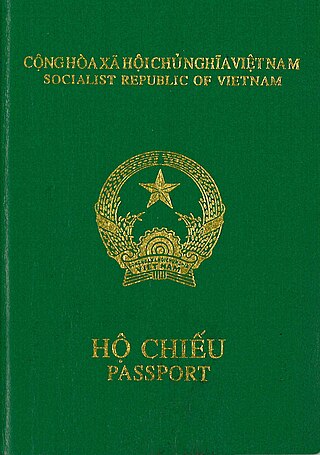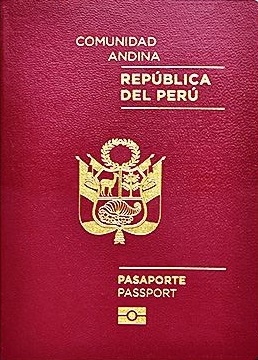
A visa is a conditional authorization granted by a polity to a foreigner that allows them to enter, remain within, or leave its territory. Visas typically include limits on the duration of the foreigner's stay, areas within the country they may enter, the dates they may enter, the number of permitted visits, or if the individual has the ability to work in the country in question. Visas are associated with the request for permission to enter a territory and thus are, in most countries, distinct from actual formal permission for an alien to enter and remain in the country. In each instance, a visa is subject to entry permission by an immigration official at the time of actual entry and can be revoked at any time. Visa evidence most commonly takes the form of a sticker endorsed in the applicant's passport or other travel document but may also exist electronically. Some countries no longer issue physical visa evidence, instead recording details only in immigration databases.

The Hong Kong Special Administrative Region of the People's Republic of China passport is a passport issued only to permanent residents of Hong Kong who also hold Chinese citizenship. In accordance with the Basic Law of the Hong Kong Special Administrative Region, since the transfer of sovereignty on 1 July 1997, the passport has been issued by the Immigration Department of the Government of Hong Kong under the authorisation of the Central People's Government of the People's Republic of China. As the official languages of Hong Kong are Chinese and English, the passport is printed bilingually in both Chinese and English.

The visa policy of Australia deals with the requirements that a foreign national wishing to enter Australia must meet to obtain a visa, which is a permit to travel, to enter and remain in the country. A visa may also entitle the visa holder to other privileges, such as a right to work, study, etc. and may be subject to conditions.

Visitors to the United States must obtain a visa from one of the U.S. diplomatic missions unless they come from one of the visa-exempt or Visa Waiver Program countries. The same rules apply for travel to all U.S. states, Washington, D.C., Puerto Rico and the U.S. Virgin Islands, as well as to Guam and the Northern Mariana Islands with additional waivers, while similar but separate rules apply to American Samoa.

Visitors to the Republic of China (Taiwan) must obtain a visa or authorization in advance, unless they come from one of the visa exempt countries or countries whose nationals are eligible for visa on arrival. All visitors must hold a passport valid for 6 months.
Visitors to the mainland of the People's Republic of China must obtain a visa from one of the Chinese diplomatic missions, unless they are a national of one of the visa-exempt countries. The two special administrative regions – Hong Kong and Macau – maintain their own independent border control policies and thus have their own separate visa requirements.

The visa policy of Hong Kong deals with the requirements in which a foreign national wishing to enter Hong Kong through one of the 15 immigration control points must meet to obtain an entry permit or Visa, which depending on the traveller's nationality, may be required to travel to, enter, and remain in the Hong Kong Special Administrative Region. Visitors from over 145 countries are permitted without Visa entry for periods ranging from 7 to 180 days, to the Hong Kong Special Administrative Region for tourism or certain business-related activities. All visitors must hold a passport valid for more than 1 month.

Visa requirements for Taiwanese citizens are administrative entry restrictions by the authorities of other states placed on nationals of the Republic of China (Taiwan) who have also established household registration in Taiwan. The law of Taiwan has a distinction on its nationals' right of abode to its territory for those with or without household registration in Taiwan.

Visa requirements for Vietnamese citizens are administrative entry restrictions imposed on citizens of Vietnam by the authorities of other states. As of July 2022, Vietnamese citizens had visa-free or visa on arrival access to 54 countries and territories, ranking the Vietnamese passport 90th in terms of travel freedom according to the Henley Passport Index.

Visa requirements for Peruvian citizens are administrative entry restrictions by the authorities of other states placed on citizens of Peru. As of July 20th, 2023, Peruvian citizens had visa-free or visa on arrival access to 138 countries and territories, ranking the Peruvian passport 33th overall and 7th in the American continent in terms of world travel freedom according to the Henley Passport Index.
Visa requirements for Papua New Guinean citizens are administrative entry restrictions by the authorities of other states placed on citizens of Papua New Guinea. As of 2 July 2019, Papua New Guinean citizens had visa-free or visa on arrival access to 82 countries and territories, ranking the Papua New Guinean passport 64th in terms of travel freedom according to the Henley Passport Index.
The visa policy of the Philippines is governed by Commonwealth Act No. 613, also known as the Philippine Immigration Act, and by subsequent legislation amending it. The Act is jointly enforced by the Department of Foreign Affairs (DFA) and the Bureau of Immigration (BI). Visitors from 157 countries are permitted visa-free entry for periods ranging from 14 to 59 days.

The visa policy of the United Kingdom is the policy by which His Majesty's Government determines visa requirements for visitors to the United Kingdom, and the Crown dependencies of Guernsey, Jersey, and the Isle of Man and those seeking to work, study or reside there. All intended entrants must obtain a visa unless they are exempt.

e-Channel, also known as The Automated Passenger Clearance System, is an expedited border control system introduced by the Hong Kong Immigration Department in 2004, designed to speed up border immigration processes for residents of Hong Kong, Macau and frequent visitors to Hong Kong entering and exiting the territory whether it be by land, air or sea via the use of self-service kiosks employed at various border control points.
The visa policy of Malaysia consists of the requirements for foreign nationals to travel to, enter, and remain in Malaysia. Most visitors to Malaysia are granted visa-free entry for a period of 90, 30, or 14 days respectively. However, nationals from some countries must first obtain a visa from one of the Malaysian Diplomatic Missions before being allowed into the country. All visitors must hold a passport valid for at least 6 months.

Visitors to Thailand must obtain a visa from one of the Thai diplomatic missions unless they come from a visa-exempt country or a country whose citizens are eligible to obtain visas on arrival/eVisa.

Non–New Zealand citizens wishing to enter the Realm of New Zealand must obtain a visa unless they are

The visa policy of Singapore deals with the requirements to enter Singapore. A foreign national, depending on their country of origin, must meet certain requirements to obtain a visa, which is a permit to travel, to enter and remain in the country. A visa may also entitle the visa holder to other privileges, such as a right to work, study, etc. and may be subject to conditions.

Automated border control systems (ABC) or eGates are automated self-service barriers which use data stored in a chip in biometric passports along with a photo or fingerprint taken at the time of entering the eGates to verify the passport holder's identity. Travellers undergo biometric verification using facial or iris recognition, fingerprints, or a combination of modalities. After the identification process is complete and the passport holder's identity is verified, a physical barrier such as a gate or turnstile opens to permit passage. If the passport holder's identification is not verified or if the system malfunctions, then the gate or turnstile does not open and an immigration officer will meet the person. E-gates came about in the mid-2000s as an automated method of reading the then-newly ICAO mandated e-passports.
An electronic visa, electronic entry visa or electronic travel authorisation/electronic travel authority (ETA) is a travel permit in an electronic form. It is often required in addition to a valid passport for access into a particular jurisdiction.
















